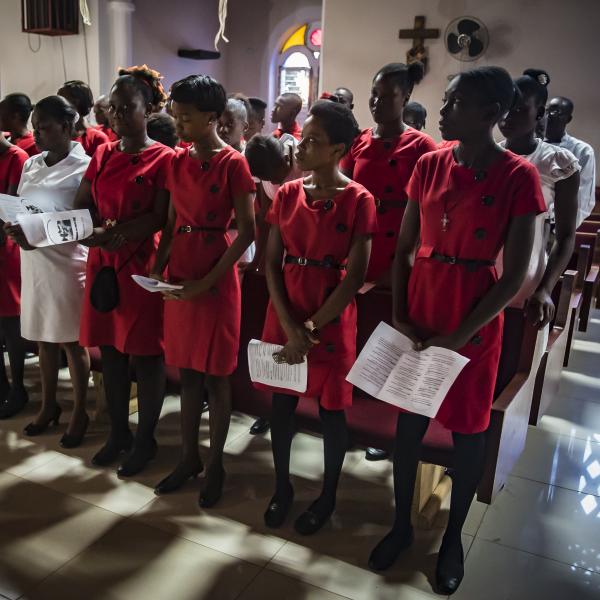How to activate and strengthen local faith communities
Last week, we looked at an article from Dr. TJ D’Agostino, Dr. Nikhit D’Sa, and Dr. Neil Boothby on the role of local faith communities (LFCs) in supporting child development and learning. The authors’ scoping study “What’s faith got to do with it?” revealed that while many international actors recognize the potential benefits of engaging faith-leaders and LFCs to promote child development and learning, very few have done so in a way that activates and strengthens existing LFCs. Rather, international actors will frequently use LFCs as messengers to promote their development goals related to children or collaborate with LFCs as local assets or partners. While there is value in these approaches, the authors argue for an approach that seeks to recognize and support faith-communities as existing systems that support child development and learning. Ultimately, doing so will be more sustainable, respectful, and effective.
All of this of course begs the question of how can actors strengthen and activate existing systems in a meaningful way that also mitigates the potential risks of working with LFCs while optimizing their opportunities. (Last week, we also looked at these potential risks and opportunities. You can revisit them here). This week we will look at the Global Center for the Development of the Whole Child’s (GC-DWC) Strong Beginnings program in Haiti that seeks to strengthen the Catholic parish system in communities to make education more accessible and equitable.
Over the past fourteen years, Notre Dame’s Institute for Educational Initiatives (IEI) through its Alliance for Catholic Education (ACE) and the GC-DWC have been embedded in the education system in Haiti, working to understand the richness of the culture as well as the intricate and complex challenges schools and local communities face. To pause, this is a really great starting point to strengthening and activating an existing system. Actors looking to strengthen and further activate existing systems need to first invest the time and resources to genuinely understand the contexts in which they work. It is through this deep investment of time that Notre Dame has been able to understand the impact of Haiti’s colonial past and racial exclusion on its education system.
In 1804, Haiti won its independence from a colonial power, France, via a revolution of slaves, becoming the first black, sovereign nation in the world. However, an “independence debt” of $21 billion, enforced by France and nations that feared similar revolutions, precluded Haiti from joining the world economy and left a lasting, colossal impact on Haiti’s growth and development. For over a century, eighty percent of Haiti’s annual revenue went toward serving this debt at the expense of investments in education, healthcare, and infrastructure. Today, Haiti is the poorest nation in the Western Hemisphere (World Bank 2019), and Haiti’s history of racial exclusion has manifested itself in insufficient systems, unable to meet the holistic needs of children and families.
Given the reality of the frailty of Haiti’s current education system, the GC-DWC looked to other functioning and effective systems in Haiti that could hold the key to improving education for future generations of learners by making it more accessible and equitable. The Catholic Church stood out as one of the most efficient, pre-existing systems in Haiti. Given its influence at the national, regional, and local levels and its responsibility for nearly 30% of education in Haiti, it is an excellent LFC to work with and strengthen in order to improve education in Haiti.
What this actually looks like though is also a challenge. The GC-DWC’s work globally has indicated that a whole-child approach to education that leverages the most active elements of a child’s social ecology is often the most effective approach. In Haiti, each Catholic parish runs a school and is deeply embedded in local culture and home life. Therefore, the GC-DWC activates this parish network to meet children’s holistic needs at all three levels of their social ecology: the home, school, and church. Innovative interventions along this system include integrating child development and positive parenting messages into sermons and baptismal preparation courses; implementing high-quality literacy and SEL curricula in parish schools, with an emphasis on Haitian identity and empowerment; creating opportunities for families to learn together at home; and introducing nutrition education and resources to combat stunting.
By working directly with parish leaders (priests, sisters, and laity) to design interventions and programming, the GC-DWC recognizes the autonomy, experience, knowledge, and influence of the local Church and empowers them to address the most pertinent needs they see in their community. The ultimate goal of the project is to equip local parish communities with the resources they need to sustain and adapt programming as is necessary in their community. Therefore, by building the capacity of this LFC through workshops and trainings on program development, measurement and evaluation, sustainability, and program refinement, the GC-DWC strives to cultivate a response that will ultimately be the most sustainable, effective and respectful for the communities in which it works.

